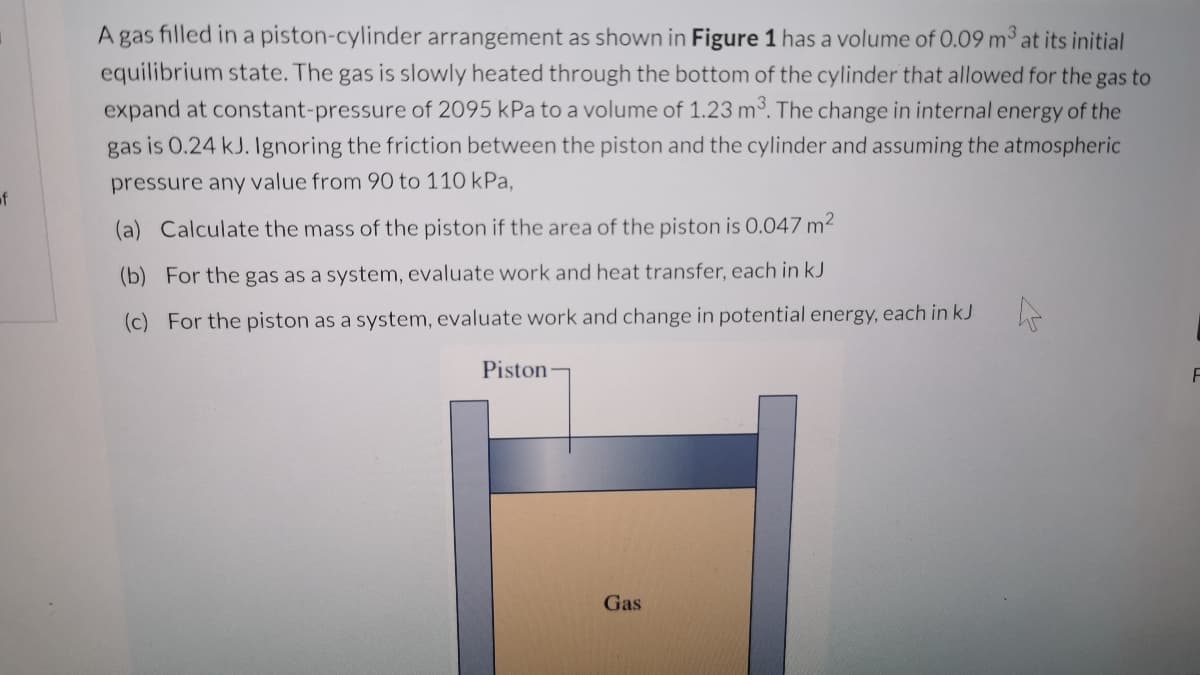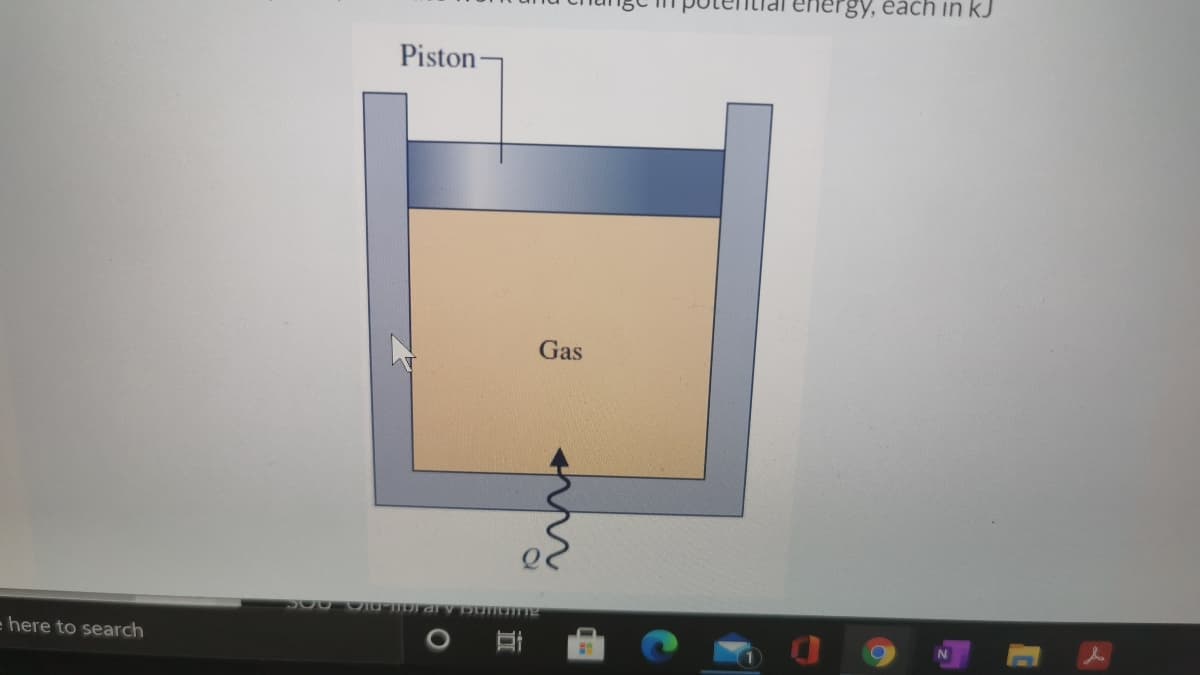A gas filled in a piston-cylinder arrangement as shown in Figure 1 has a volume of 0.09 m³ at its initial equilibrium state. The gas is slowly heated through the bottom of the cylinder that allowed for the gas to expand at constant-pressure of 2095 kPa to a volume of 1.23m°. The change in internal energy of the gas is 0.24 kJ. Ignoring the friction between the piston and the cylinder and assuming the atmospheric pressure any value from 90 to 110 kPa, (a) Calculate the mass of the piston if the area of the piston is 0.047 m2 (b) For the gas as a system, evaluate work and heat transfer, each in kJ (c) For the piston as a system, evaluate work and change in potential energy, each in kJ Piston-
A gas filled in a piston-cylinder arrangement as shown in Figure 1 has a volume of 0.09 m³ at its initial equilibrium state. The gas is slowly heated through the bottom of the cylinder that allowed for the gas to expand at constant-pressure of 2095 kPa to a volume of 1.23m°. The change in internal energy of the gas is 0.24 kJ. Ignoring the friction between the piston and the cylinder and assuming the atmospheric pressure any value from 90 to 110 kPa, (a) Calculate the mass of the piston if the area of the piston is 0.047 m2 (b) For the gas as a system, evaluate work and heat transfer, each in kJ (c) For the piston as a system, evaluate work and change in potential energy, each in kJ Piston-
Elements Of Electromagnetics
7th Edition
ISBN:9780190698614
Author:Sadiku, Matthew N. O.
Publisher:Sadiku, Matthew N. O.
ChapterMA: Math Assessment
Section: Chapter Questions
Problem 1.1MA
Related questions
Question

Transcribed Image Text:A gas filled in a piston-cylinder arrangement as shown in Figure 1 has a volume of 0.09 m³ at its initial
equilibrium state. The gas is slowly heated through the bottom of the cylinder that allowed for the gas to
expand at constant-pressure of 2095 kPa to a volume of 1.23 m°. The change in internal energy of the
gas is 0.24 kJ. Ignoring the friction between the piston and the cylinder and assuming the atmospheric
pressure any value from 90 to 110 kPa,
of
(a) Calculate the mass of the piston if the area of the piston is 0.047 m2
(b) For the gas as a system, evaluate work and heat transfer, each in kJ
(c) For the piston as a system, evaluate work and change in potential energy, each in kJ
Piston
Gas

Transcribed Image Text:energy, each in kJ
Piston-
Gas
e here to search
Expert Solution
This question has been solved!
Explore an expertly crafted, step-by-step solution for a thorough understanding of key concepts.
This is a popular solution!
Trending now
This is a popular solution!
Step by step
Solved in 2 steps with 1 images

Knowledge Booster
Learn more about
Need a deep-dive on the concept behind this application? Look no further. Learn more about this topic, mechanical-engineering and related others by exploring similar questions and additional content below.Recommended textbooks for you

Elements Of Electromagnetics
Mechanical Engineering
ISBN:
9780190698614
Author:
Sadiku, Matthew N. O.
Publisher:
Oxford University Press

Mechanics of Materials (10th Edition)
Mechanical Engineering
ISBN:
9780134319650
Author:
Russell C. Hibbeler
Publisher:
PEARSON

Thermodynamics: An Engineering Approach
Mechanical Engineering
ISBN:
9781259822674
Author:
Yunus A. Cengel Dr., Michael A. Boles
Publisher:
McGraw-Hill Education

Elements Of Electromagnetics
Mechanical Engineering
ISBN:
9780190698614
Author:
Sadiku, Matthew N. O.
Publisher:
Oxford University Press

Mechanics of Materials (10th Edition)
Mechanical Engineering
ISBN:
9780134319650
Author:
Russell C. Hibbeler
Publisher:
PEARSON

Thermodynamics: An Engineering Approach
Mechanical Engineering
ISBN:
9781259822674
Author:
Yunus A. Cengel Dr., Michael A. Boles
Publisher:
McGraw-Hill Education

Control Systems Engineering
Mechanical Engineering
ISBN:
9781118170519
Author:
Norman S. Nise
Publisher:
WILEY

Mechanics of Materials (MindTap Course List)
Mechanical Engineering
ISBN:
9781337093347
Author:
Barry J. Goodno, James M. Gere
Publisher:
Cengage Learning

Engineering Mechanics: Statics
Mechanical Engineering
ISBN:
9781118807330
Author:
James L. Meriam, L. G. Kraige, J. N. Bolton
Publisher:
WILEY